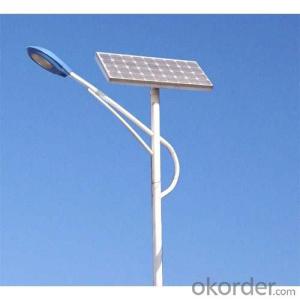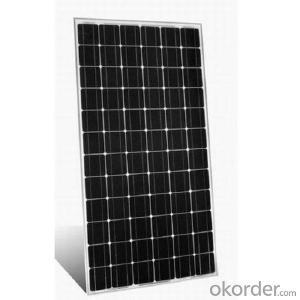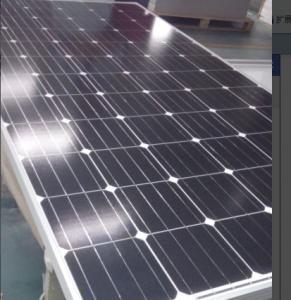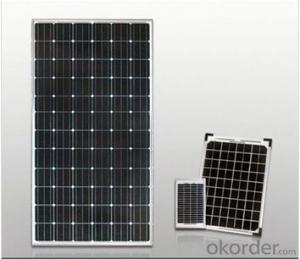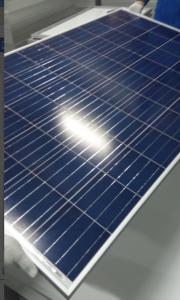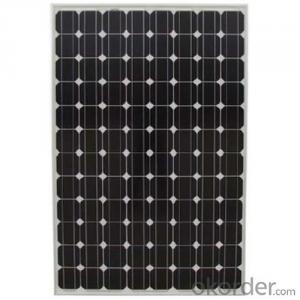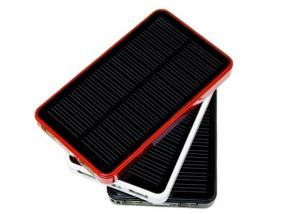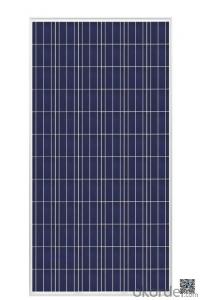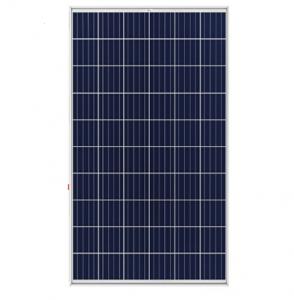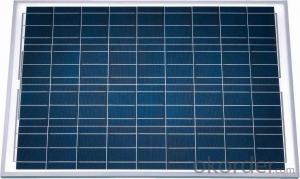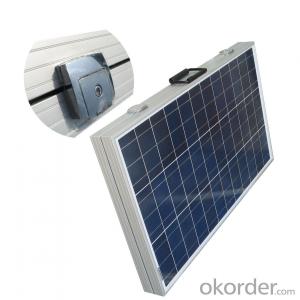Portable Solar Panels for Camping - High Quality Solar Product W02
- Loading Port:
- Shanghai
- Payment Terms:
- TT OR LC
- Min Order Qty:
- 90 watt
- Supply Capability:
- 9000000 watt/month
OKorder Service Pledge
OKorder Financial Service
You Might Also Like
Specification
1, Product desciption
Inverter circuits designed to produce a variable output voltage range are often used within motor speed controllers.
Inverters convert low frequency main AC power to higher frequency for use in induction heating.
To do this, AC power is first rectified to provide DC power. The inverter then changes the DC power to high frequency AC power. Due to the reduction in the number of DC Sources employed, the structure becomes more reliable and the output voltage has higher resolution due to an increase in the number of steps so that the reference sinusoidal voltage can be better achieved.
The DC power for the inverter section can be derived from a normal AC wall outlet or some other source. Control and feedback circuitry is used to adjust the final output of the inverter section which will ultimately determine the speed of the motor operating under its mechanical load.
Motor speed control needs are numerous and include things like: industrial motor driven equipment, electric vehicles, rail transport systems, and power tools. (See related: variable-frequency drive ) Switching states are developed for positive, negative and zero voltages as per the patterns given in the switching Table.
Inverters convert low frequency main AC power to higher frequency for use in induction heating.
To do this, AC power is first rectified to provide DC power. The inverter then changes the DC power to high frequency AC power. Due to the reduction in the number of DC Sources employed, the structure becomes more reliable and the output voltage has higher resolution due to an increase in the number of steps so that the reference sinusoidal voltage can be better achieved.
The generated gate pulses are given to each switch in accordance with the developed pattern and thus the output is obtained.
Solar power is energy from the sun. "Solar" is the Latin word for "sun" and
And Powerful source of energy. Without it, there will be no life.
Solar energy is considered as a serious source of energy for many years
of the vast amounts of energy that is made freely available, if harnessed by modern technology.
A magnifying glass can be used to heat up a small amount of water.
The short piece of copper tube is sealed at one end and filled with water.
And magnifying glass is then used to warm up the pipe.
Using more than one magnifying glass will increase the temperature more rapidly.
2, Features of the product
Inverters convert low frequency main AC power to higher frequency for use in induction heating.
To do this, AC power is first rectified to provide DC power. The inverter then changes the DC power to high frequency AC power. Due to the reduction in the number of DC Sources employed, the structure becomes more reliable and the output voltage has higher resolution due to an increase in the number of steps so that the reference sinusoidal voltage can be better achieved.
This configuration has recently become very popular in AC power supply and adjustable speed drive applications. This new inverter can avoid extra clamping diodes or voltage balancing capacitors. There are three kinds of level shifted modulation techniques, namely: 1,High and stable conversion efficienly based on over 4 years professional experience
2 ,High reliability with guaranteed +/-10% output power tolerance
3,Proven materials,tempered front glass,and a sturdy anodized aluminum frame allow modules to operate reliably in multiple mountily configurations
4,Combination of high efficicncy and attractive appearance
The first thing to figure out is the length of road in need of street lights.
This can be a small entrance road only a couple hundred of feet long to miles of streets through an area. Does the area currently have any type of lighting available.
What is the reason for needing street lights in this area
3, Detailed Specification
Data Sheet of High Quality Solar Controller Tracer-1210RN
ModelTracer-1210RN
Rated system voltage12/24V auto work
Rated battery current10A
Rated load current10A
Max.battery voltage32V
Max.PV open circuit voltage100VDC
Max.PV input power12V 130W;24V 260W
Self-consumption<10ma(24v)< p="">
Charge Circuit Voltage<=0.26v< p="">
Discharge Circuit Voltage Drop<=0.15v< p="">
CommunicationTTL232/8 pin RJ45
4, Product Image
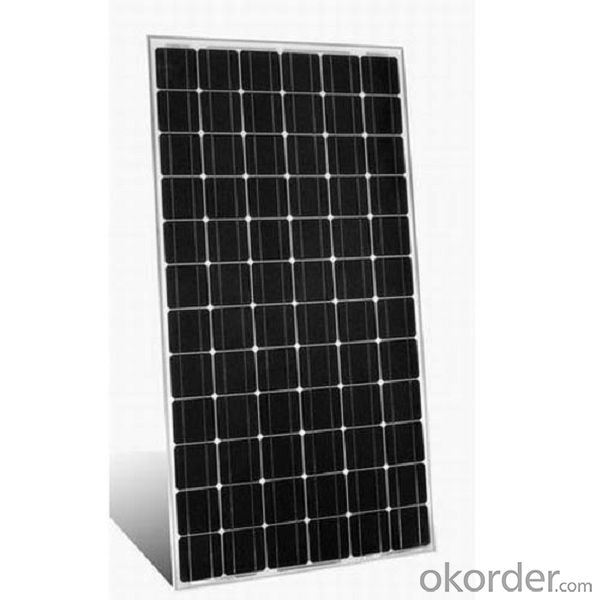
- Q: I need to be able to charge a 2v 7amp battery with a solar panel. I understand that the charge controller will keep the battery from over charging/discharging, but what I don't understand is the amps.The solar panel is rated at 5watts.The solar panel comes with a 2v 3amp charge controller but will I need to buy a 7amp charge controller and replace it with that for my battery pack? Please explain. Thanks in advance.
- If it is a charge controller that is wired between the panel and the battery only, then a 3A rating is ample. The controller only has to handle the maximum current that the solar panel can output. The panel will have (or needs to have) an open-circuit voltage that is greater than about 4V in order to actually charge the battery, whose terminal voltage will rise above 2V as it charges. The panel's open circuit output voltage typically is about 7V. The 5W rating is at the maximum power point under the illumination of standard sun and at a specified temperature. That maximum power point probably is around 4V, which means the panel will deliver the following amperage to charge the battery: I = P/V = 5W/4V = 0.36A Since 0.36A is well below the 3A rating of the controller, the controller will not be overloaded when charging the battery. Some charge controllers also have terminals for connecting the load that you want to power. If that's the case, then the controller also needs to be rated to handle that load amperage or higher. If you were to connect a 6A load, then you would like to have say a 0A controller. Hope that helps.
- Q: How can I determine the size of solar panel system I need?
- To determine the size of the solar panel system you need, you should consider your average electricity consumption, your location's solar potential, and the available roof or ground space for installation. Start by analyzing your energy bills to understand your average monthly and annual electricity usage. Then, consider the solar irradiation levels in your area, which can be found through online tools or consulting a solar professional. Additionally, assess the available area for installation, as larger systems require more space. Finally, consult with a solar installer or use online calculators to determine the appropriate system size that can meet your energy needs.
- Q: Can solar panels be used to power a greenhouse?
- Yes, solar panels can be used to power a greenhouse. Solar panels convert sunlight into electricity, which can then be used to power various electrical systems in a greenhouse, such as lighting, ventilation, heating, and irrigation. This renewable energy source offers an environmentally friendly and cost-effective solution for greenhouse operations.
- Q: how much energy does solar panels save you? (like a month, year, etc)
- It depends on the size of the solar panels and the intensity of the solar-light. So, there's difference in every place. It's impossible to answer unless there's detail of panel size, panel quantities, average rainfall, average solar days, etc.
- Q: I am looking at a need of roughly 30w/hour need per 24 hour period. I have spent several hours now looking for information online and have found plenty of info regarding the panels themselves, but information regarding the batteries backups have been slim. I understand that there is a 5-7 hour peak time to collect the energy. I am looking for information regarding the batteries themselves. How do the batteries work, what size batteries should I look for, and what is the life expectency for the batteries? Any website links would also be appreciated!
- Solar panels have their own characteristics and generate current depending on the intensity of sunlight falling on them and not on the temperature. Direction of the panel also makes lots of difference. Nowadays very thin panels are available at very high cost. The more area a panel occupies it generates more current. The current generated by a panel cannot be readily used since the current and voltage varies with the load connected to it. So normally a regulator is used to have constant voltage and constant current to come from the panel. This charges the battery. You have to calculate the total/normal current from the charger and then find the AH of the battery. When you have calculated the AH of the panel/charger then you can divide the AH of the battery by the AH of the charger/panel and find out the time taken to fully charge the battery. You also have to remember that there is a de-rating factor to be taken into consideration in the battery.
- Q: I'm trying to charge rechargeable AA batteries with a solar panel. What gauge wire should I use to connect the panel to the batteries? I know I'm not going to have a lot of current going through so the wire size doesn't really matter. Can the wire be too thick thoShould I ugh? Should I use a diode to keep the batteries from overpowering the circuit? If so, what size diode? My panel is 4.8V 50mA. Can I just hook the panel straight into the batteries or do I need something else?
- In order: .? Just about any wire will do.? You can handle 50 mA over just about anything, even 28 gauge telephone wire.? Your biggest problems are probably going to be mechanical stress (you want stranded wire instead of solid, to avoid breakage) and dealing with the size of larger wires. 8 gauge speaker wire may be a good optimum. 2.? You need a diode.? If you're charging NiMH or NiCd cells you're going to have about .25 volts/cell; you can charge up to 3 of them in series with a 4.8 volt panel.? The solar panel is a bunch of diodes itself, but they're leaky in the reverse direction; the diode prevents the batteries from discharging themselves back through the panel.? You want a Schottky-barrier diode, because the forward voltage drop is about 0.2 volts instead of 0.7 volts for a regular silicon rectifier.? This gives you maximum current output from your panel.
- Q: i also need to know how does a solar panel work
- solar panel convert sunlight into electricity,The controller is connected between the photovoltaic panels and batteries,it makes electricity generated from solar panels charge batteries.
- Q: I live in Hawaii and having a solar panel is not a bad idea since we have plenty of sun the only problem is that it cost a lot of money and takes many years before you get your money back. There are kits available where you can make and install your own solar panel and wind turbine but is it bull **** or is it a good deal?
- go with wind power
- Q: Can solar panels be damaged by hail or strong winds?
- Yes, solar panels can be damaged by hail or strong winds. Hailstones can cause cracks or fractures in the glass surface of the panels, affecting their efficiency. Additionally, strong winds can potentially dislodge or break the panels if they are not properly installed or secured.
Send your message to us
Portable Solar Panels for Camping - High Quality Solar Product W02
- Loading Port:
- Shanghai
- Payment Terms:
- TT OR LC
- Min Order Qty:
- 90 watt
- Supply Capability:
- 9000000 watt/month
OKorder Service Pledge
OKorder Financial Service
Similar products
Hot products
Hot Searches
